| Saturn photos
with CCD web camera A, Saturn
B,
Saturn's moons
A,
Saturn
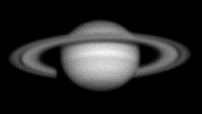
Picture
resolution: 26.3"/pix
Click the image to see full size photo (0.21"/pix) |
Saturn. 28.04.2007, 22:32 (20:32 UT)
CCD Resolution: 0.42 arcsec/pixel
Telescope: 8" OrionOptics Newtonian (f=1200mm)
Camera: Lumenera
Lu075M (Monochrome) + Barlow 3X
Filters: IR blocking filter
Result focal length: 3600mm
Exposure: 800x1/30s (gain 8.0)
Seeing: quite turbulent air
Temperature: ~14°C
Captured and processed: K3CCDTools
3 + Corel PhotoPaint
Processing details:
1, Captured 2166 frames in K3CCDTools (72 seconds @ 30fps)
2, Planetary Wizard in K3CCDTools with X2
resampling
3, Selected best quality 800 frames
4, Stacked
5, Histogram processing with Unsharp mask (3; 0;
900)
6, Resized in Corel PhotoPaint to 80%
7, Brightness-Contrast-Intensity adjustment in
PhotoPaint
8, Slight sharpening in PhotoPaint
|
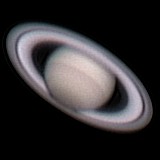
Click the image to see full size photo (0.16"/pix) |
Saturn. 26.12.2002, 01:55
(00:55 UT)
Resolution: 0.32 arcsec/pixel
Telescope: 8" OrionOptics Newtonian (f=1200mm)
Camera: Vesta 675SC2 + Barlow 3X
Result focal length: 3600mm
Exposure: 240x1/15s (gain 80%)
Seeing: rather steady air
Temperature: -12°C
Captured and processed: K3CCDTools
+ Corel PhotoPaintFinally I captured Cassini
division visible along the whole ring! Also a
thin shadow of Saturn's body is visible on the
left side of ring. It proves that Saturn is after
oposition (it was 17.12.2002).
Processing details:
1, Captured 509 frames in K3CCDTools
2, Planetary Wizard in K3CCDTools with X2
resampling
3, Selected best quality 270 frames
4, Manually deselected 30 frames (with worst
detail in Cassini division)
5, Stacked
6, Histogram processing with Unsharp mask (4; 0;
400)
7, Resized in Corel PhotoPaint to 50%
8, Brightness-Contrast-Intensity adjustment in
PhotoPaint (3; 11; 0)
9, Slight color saturation adjustment in
PhotoPaint (+2)
|
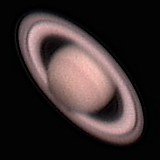
Click the image to see full size photo (0.16"/pix) |
Saturn. 12.12.2002, 02:58
(01:58 UT)
Resolution: 0.32 arcsec/pixel
Telescope: 8" OrionOptics Newtonian (f=1200mm)
Camera: Vesta 675SC2 + Barlow 3X
Result focal length: 3600mm
Exposure: 100x1/15s (gain 50%)
Seeing: rather high air turbulence (from balcony...)
Temperature: -6.6°C
Captured and processed: K3CCDTools
+ Corel PhotoPaintThe effect of Barlow 3X
instead of Barlow 2X is clearly visible - higher
resolution with more details.
Now the Cassini division is visible almost along
the whole ring. But still a lot of space for
further improvement to future.
Processing details:
1, Captured 448 frames in K3CCDTools
2, Planetary Wizard in K3CCDTools with X2
resampling
3, Selected best quality 200 frames
4, Sorted by Difference - deselect worst 40
frames (with higher difference)
6, Manually deselected 60 frames (with worst
detail in Cassini division)
7, Stacked
8, Histogram processing with Unsharp mask (4; 0;
400)
9, Resized in Corel PhotoPaint to 50% + slight
noise reduction
Note: Full size photo is direct result
from K3CCDTools (no PhotoPaint processing)
|
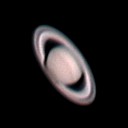
Click the image to see full size photo (0.24"/pix) |
Saturn. 05.02.2002, 21:57
(20:57 UT)
Resolution: 0.48 arcsec/pixel
Telescope: 8" OrionOptics Newtonian (f=1200mm)
Camera: Vesta 675SC + Barlow 2X
Result focal length: 2400mm
Exposure: 100 frames stacked, unknown exposure
Captured and processed: K3CCDTools
+ Corel PhotoPaintThe Saturn is 2 months after
opposition - we can see that shadow of Saturn's
body on rings is on another side than it was in
November (see a photo bellow ). Saturn's
opposition was 03.12.2001.
|
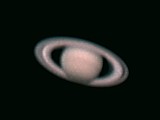
Click the
image to see higher resolution (0.24"/pix)
image |
Saturn. 11.11.2001, 02:49
(0:49 UT)
Resolution: 0.48 arcsec/pixel
Telescope: 8" OrionOptics Newtonian (f=1200mm)
Camera: Vesta 675SC + Barlow 2X
Result focal length: 2400mm
Exposure: 40x1/33s (gain 60%)
Seeing: air turbulence
Processing: K3CCDTools + Corel PhotoPaint
This is my first Saturn with my Orion Optics Europa
200 scope.
The motor drive was turned off while capturing
AVI file. |
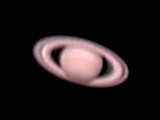
Click the
image to see higher resolution (0.24"/pix)
image |
Saturn. 11.11.2001, 02:49
(0:49 UT)
The same AVI source as above, but processed with
AstroStack |

Click the
image to see higher resolution image |
Saturn. 22.12.2000, 23:52
(22:52 UT)
Telescope: 150mm
Newtonian telescope (f=1000mm)
Camera: Vesta Pro 680K at prime focus
Result focal length: 1000mm
The scope was of very poor quality, that's why I
returned it to seller |
B, Saturn's moons
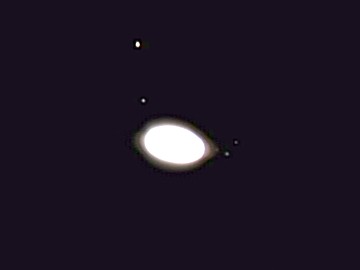
Move mouse
pointer above picture to see labels |
Saturn's moons. 26.12.2002,
00:52 (25.12.2002 23:52 UT)
Resolution: 0.96 arcsec/pixel
Telescope: 8" OrionOptics Newtonian (f=1200mm)
Camera: Vesta 675SC2 at prime focus
Result focal length: 1200mm
Exposure: 136x1/5s (gain 100%)
Seeing: rather steady air
Temperature: -12°C
Captured and processed: K3CCDToolsI
used my Vesta 675SC2 in normal (i.e. not long
exposure) mode. I was surprised that after
summation of 134 frames I was able to see 11.4 mag
Enceladus moon!
The "ears" on left and right side of
Saturn are caused by diffraction (on secondary
mirror holder).
Here is a table with Saturn's moons data at
the time of exposure (taken from SkyMap Pro):
| ID |
Mag |
Position
Angle |
Separation |
Name |
| I |
12.6 |
288° |
24.6" |
Mimas |
| II |
11.4 |
269° |
40.0" |
Enceladus |
| III |
9.9 |
266° |
50.3" |
Tethys |
| IV |
10.1 |
278° |
58.3" |
Dione |
| V |
9.4 |
41° |
53.5" |
Rhea |
| VI |
8.0 |
26° |
104.4" |
Titan |
| VII |
13.9 |
107° |
220.0" |
Hyperion |
| VIII |
10.8 |
93° |
396.1" |
Iapetus |
Processing details:
1, Captured 199 frames in K3CCDTools
2, Aligned in K3CCDTools
3, Sorted according quality and selected best
quality 134 frames
5, Summed
6, Histogram stretching + gamma 1.90 + Unsharp
mask (2; 0; 100)
|
Back to
Solar System Page
Computer generated images,
real images, drawings and texts are property of the
author and may not be reproduced or used without
permission of author.

Last Update:
02.05.2007
|